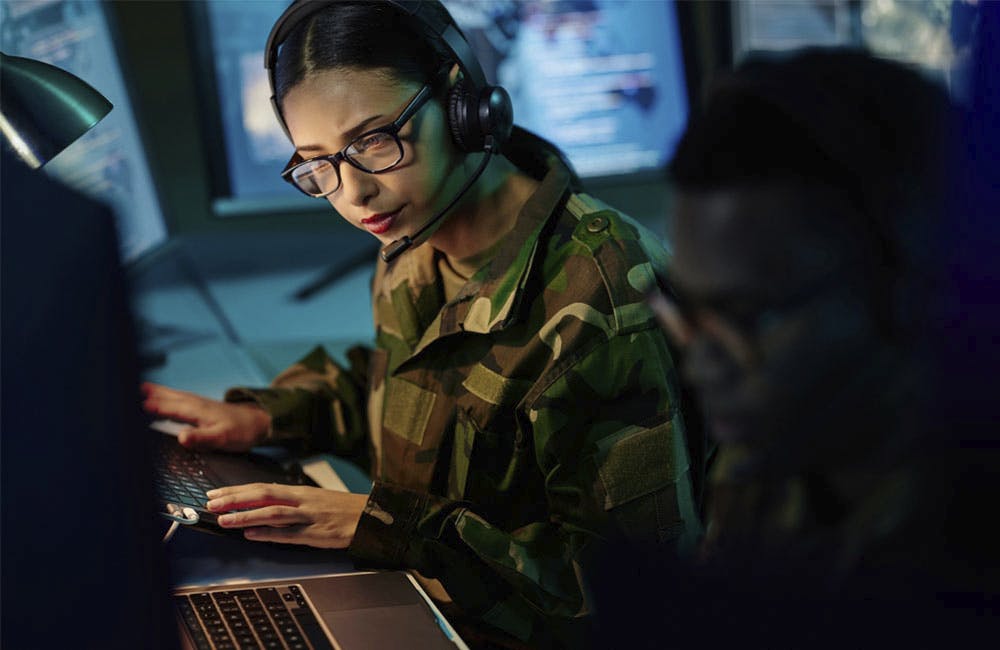Army CIOs Eye Interoperability Amid Cloud, Zero Trust
Officials are preparing for challenges like aligning digital modernization strategies and implementing zero-trust architectures.

Department of the Army IT leaders are prioritizing initiatives across data and cybersecurity amid cloud modernization, according to agency CIOs speaking at the AFCEA NOVA Army IT Day in McLean, Virginia, last week.
Army Corps of Engineers CIO Dovarius Peoples said that data modernization, particularly “leveraging data and being able to make decisions about information,” is a major priority for his office and cited mobility and cybersecurity as critical to his operations in 2024. Peoples said these goals are to help sift through the 600 applications the agency is examining to move the Army Corps of Engineers to the cloud.
Kenneth McNeill, CIO of the Army’s National Guard Bureau, said his agency is focused on building interoperability between the Army and Air Force. He also cited next-generation satellite communication as a 2024 goal for his office.
“We’re really in a sprint to make sure that we modernize as we go forward, especially in the area of satellite communication,” McNeill said. “We are in a sprint to make sure that we can get that capability where it needs to be.”
McNeill said these sprints are critical in allowing him to make “timely and relevant decisions” within the 54 states and territories he oversees. McNeill also touted the progress his agency has made on bring-your-own-device (BYOD) capabilities to the force. McNeill said that more than 90% of the force currently does not have this capability.
Program Executive Office Enterprise Information Systems (PEOIS) CIO Mike Chappell said his office is focused on aligning its digital modernization strategy to that of the Army’s. Chappell said PEOIS is centering itself on five strategic initiatives, including managing cybersecurity for 49 different systems that it oversees, optimizing its architecture and migrating to the cloud.
Through its Neighborhood Watch program, PEOIS serves to “advance and accelerate and supports the Army’s mission as well, to bring a lot of our applications under a single more agile solution,” Chappell added.
As the Defense Department more broadly begins overseeing zero-trust architecture implementation, the officials are also working on zero trust initiatives within the Army. McNeill said that it is important to consider interactions with local government and industry as these systems are built.
Peoples emphasized that zero trust is a “buzzword without a lot of guidance as to how to properly implement” at the local, state and federal levels, but the Army sees it differently. Peoples noted that the Army Corps of Engineers has found success by “identifying the requirements up front without trying to solve everything at one time, taking it piece by piece — because again, the goal is really to secure but to allow those that need the ability to add assets to be able to do so.”
The officials are looking at non-traditional ways of implementing zero trust as they begin identity and access management initiatives and assessing the challenges of doing so.
“Traditionally, going to every single program and re-architect out and come up with tens of millions of dollars of change for a single program, for a minor change to our access management is not sustainable. So how do we do this at scale across all of our programs, and then repeat that process for all of 140-plus different activities to actually implement zero trust is a challenging thing,” Chappell said.
This is a carousel with manually rotating slides. Use Next and Previous buttons to navigate or jump to a slide with the slide dots
-

How TMF is Helping Agencies Accelerate Tech Modernization
The program launched a new AI pilot to expedite TMF applications as agency leaders urge more to consider applying for funds.
4m read -

Sea-Air-Space: Zero Trust is ‘The Best Approach’ For Military Cybersecurity
Marines Cyber Technology Officer Shery Thomas discusses identity management across networks and devices.
10m watch -

How Agencies are Justifying Budget Growth in AI, Zero Trust
IT leaders stressed the importance of understanding user knowledge and needs when prioritizing cybersecurity projects.
3m read -

DOJ Weighs 'Bring Your Own Devices' Amid Increased Threats
The agency wants stronger industry standards around cybersecurity before considering a more tailored mobile device policy.
2m read








